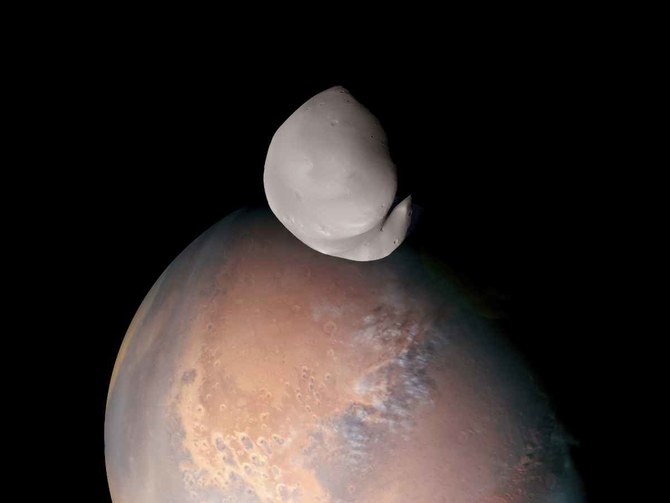
- ARAB NEWS
- 05 Jul 2025

CAPE CANAVERAL, Florida: A spacecraft around Mars has sent back the most detailed photos yet of the red planet’s little moon.
The UAE’s Amal spacecraft flew within 100 km of Deimos last month and the close-up shots were released on Monday.
Amal — Arabic for Hope — got a two-for-one when Mars photobombed some of the images. It was the closest a spacecraft has been to Deimos in almost a half-century.
The spacecraft also observed the little explored far side of the odd-shaped, cratered moon, 15 km by 12 km by 12 km.
Mars’ other moon, Phobos, is almost double that size and better understood since it orbits much closer to Mars — just 6,000 km away, the closest of any planet’s moon in our solar system.
Deimos’ orbit around Mars stretches 23,000 km out. That’s close to the inner part of the spacecraft’s orbit — “which is what made observing Deimos such a compelling idea,” said the mission’s lead scientist Hessa Al-Matroushi.
“Phobos has got most of the attention up until now — now it’s Deimos’ turn!” she added in an email.
Al-Matroushi and other scientists with the UAE Space Agency said these new images indicate Deimos is not an asteroid that got captured in Mars’ orbit eons ago, the leading theory until now.
Instead, they say the moon appears to be of Martian origin — perhaps from the bigger Martian moon or from Mars itself.
The findings were presented Monday at the European Geosciences Union’s general assembly in Vienna. Amal will continue to sweep past Deimos this year, but not as closely as the March 10 encounter, according to Al-Matroushi.
NASA’s Viking 2 came within 30 km of Deimos in 1977. Since then, other spacecraft have photographed Deimos but from much farther away.
Amal rocketed to Mars on July 19, 2020, one day shy of the 50th anniversary of humanity’s first moon landing — Earth’s moon, that is — by Apollo 11’s Neil Armstrong and Buzz Aldrin.
AP